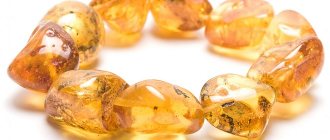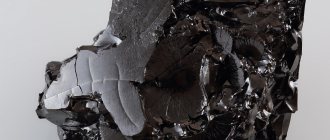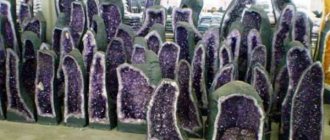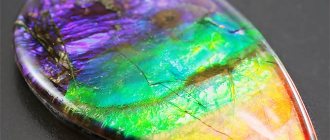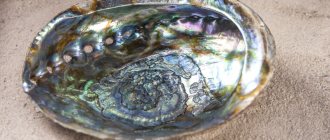- What: Ornamental;
- Deposits: Germany, Britain, Morocco, Madagascar, Russia (Ulyanovsk region, Saratov region, Tver region, Rybinsk reservoir, Republic of Dagestan), Mordovia;
- Colors: Yellow with red and blue tints;
- Mohs hardness: 3.5;
- Transparency: Transparent to opaque;
- Density: 1-1.2 g/cm³;
- Formula: -;
- Suitable person according to zodiac sign: Everyone;
- How much does it cost: from 500 rubles.
Ammonite is the fossilized shell of ancient creatures. It has the shape of a spiral, which in the culture of many peoples means an endless cycle of time, repeating, but not closing.
The spiral tells us that history can repeat itself, but nevertheless it develops, reaching a new level with each turn.
Thus, the ammonite stone was of great importance for people, reminding them of the infinity of time and the antiquity of life on Earth. It is not for nothing that the mineral is named after the powerful Egyptian god Amon.
He commanded the endless space of heaven, that which everyone saw, but no one could even touch.
Even 65 million years ago, ammonites served as protection for cephalopods, which, by the way, were also called ammonites. Mollusks have long been extinct, but their shells are still found by paleontologists around the world.
What are ammonites
Ammonites are a subclass of cephalopods that lived in the seas and oceans of the Earth in ancient times.
Today, the fossilized shells of these mollusks are also called this way.
The structure of ammonites
Mollusks have been creating their “home” all their lives.
Description of ammonite shell:
- Outwardly it looks like a round or elongated spiral.
- Inside the sink there are chamber sections. They are separated by partitions. The volume of the chambers gradually increases as you approach the open edge of the shell.
- During petrification, the jelly-like body of the mollusk decomposed, and its dwelling absorbed sand and pieces of minerals into its structure.
- The shell cavity is filled with various minerals, depending on the location of the fossilization.
- Most often, calcite and chalcedony are found inside. Iron ore and quartz elements are also found there. Thanks to this, fossilized ammonite shells have been equated to semi-precious stones.
- Some shells have not lost their mother-of-pearl shine over many centuries.
Age
Cephalopod ammonites lived in the seas and oceans during the Devonian and Cretaceous periods.
Therefore, the age of the oldest ammonite stone formations is more than 400 million years , and the youngest - at least 65 million years .
How to distinguish a natural ammonite from a fake one?
There is no point in creating copies of an ammonite. Its price is quite affordable. The intricate patterns of the mineral cannot be repeated. The investment will not be justified, since the specialist will lose more than he earns.
Jewelers prefer working with natural stone. It is very easy to distinguish a fake, and it does not require any special tests or professional skills. You just need to carefully examine the picture and you will be able to accurately identify the natural mineral.
Story
The spiral shape was revered in primitive and later cultures. It was considered mystical and divine, as it meant the eternal cycle of time: everything is repeated in this world, but with each turn it moves to a new level.
History of the name of the stone:
- The ancient Egyptians named these fossils after the Sun God and the Aries constellation Amon. His images with intricately curled ram horns are known.
- The Romans who conquered Egypt called the fossilized mollusk shells the horns of Amon.
- At the end of the 17th century, the French scientist Jacques Bruguier added the name of these fossils to the European register of paleofinds - scientists began to call them ammonites.
In Germany, ammonites were called golden snails, and in Ireland, petrified snakes.
Physicochemical characteristics
According to the mineralogical classification, ammonites are paleofauna. They are not minerals in the literal sense of the word, but contain the mineral aragonite (one of the stable forms of calcium carbonate). During fossilization, part of this mineral is replaced by pyrite and quartz.
Typically these fossilized mollusk shells are sandy, golden, brown in color. Various impurities (copper, aluminum, titanium) affect the color.
The average size of shells is 5–10 cm . But sometimes there are much more. For example, in Russia (in the Krasnodar Territory), the average diameter of mined ammonites is 1 meter , and the weight is up to 1200 kg .
Ammonites with a diameter of 2.5 m were found in Germany (Bavaria).
The layer with pearlescent tints formed on the shell of an ammonite is called ammolite. In 1981, ammolite was recognized as a precious stone.
A layer of this gem on a shell is very rare.
Colors
The color of the ammonite depends on the minerals filling the chambers of the shell. Most often these are calcites or chalcedony, which are not distinguished by their bright colors.
One of the varieties of calcite is simbircite. It is reddish or yellowish in color and resembles carnelian and amber.
The shell, covered with pyrite, sparkles like gold.
In addition, a mother-of-pearl layer is sometimes preserved inside and outside the shells.
Very rarely, a multi-colored mineral with pearlescent tints - ammolite - is formed on the shell of an ammonite. It is mined only in the Rocky Mountains region of Canada and the United States.
Appearance
Buried under a pile of sand or clay, the shell was filled with various minerals. Most often these were chalcedony and calcite. Reflecting light with cold edges, they add mystery and fabulousness to the ammonite.
No less interesting are shells containing simbircite or pyrite.
Stones that have no less magical properties than the ammonite itself. But the title of the most valuable and beautiful of the genus of ammonites rightfully deserves ammolite. The stone, which combines all possible colors, seems like a frozen piece of the rainbow.
Place of Birth
Ammonites are found in many places - where ancient seas and oceans used to be. They are extracted from sandstones and clay.
Almost every country has deposits of fossilized mollusks. They are found in large quantities in:
- Japan;
- Canada;
- USA;
- Australia;
- Western Europe;
- Russia.
Germany and Great Britain are the countries where the largest specimens are found (some are one and a half human height).
In Russia, the size of ammonites is more modest - up to 90–150 cm . These fossils are found more often in the Krasnodar and Krasnoyarsk territories, as well as in other places rich in sedimentary rocks.
A layer of ammolite (a precious iridescent stone) on shells is very rare. It is mined only in one place on the planet - in the Rocky Mountains (Canada, USA).
Application
Ammonite is considered one of the most beautiful and popular stones of biological origin. It is used in two areas: collection and jewelry and decorative.
Jewelry making, decor
Jewelry and decorative items made from ammonite are created mainly by single craftsmen.
The beauty of the stone is revealed in the cut - then a unique pattern appears, and the mother-of-pearl glow is especially clearly visible.
Flat pendants, pendants, brooches, ring inserts and earrings are made from the mineral.
Medium-sized specimens are used to make items that decorate the home.
Each product made from this gem is unique, since its shape and natural pattern are not repeated.
Collecting
This is the main segment of ammonite use. These stones have diversity in everything: shape, shades, age, deposits.
All this allows you to create large collections. In them, the sizes of exhibits can vary - from tiny to huge.
Cloudy specimens, which became so due to contact with saline solutions, also find their connoisseurs among collectors.
A particularly desirable specimen for collectors of such collections is a rock ammonite (a shell fused with rock).
Caring for stone products
Ammonite jewelry is quite fragile, so it should be stored in a separate case with a soft velvet surface inside. Fossils, like pearls and amber, cannot withstand the effects of chemical reagents. Therefore, it is better to clean jewelry in a soap solution, which is thoroughly washed off with water.
Important! In order to preserve the beauty of an ancient treasure for as long as possible, it is necessary to protect it from high temperatures and direct sunlight.
Medicinal properties
Many cultures use the amazing properties of ammonite:
- Ancient Arabic treatises describe the ability of this mineral, crushed into powder, to increase the ability of women to conceive and bear fruit.
- In ancient times in Greece and Rome, healers noticed that the stone helped with sleep disorders (intermittent sleep, lack of sleep, early awakening).
- Chinese healers studied the healing properties of ammonite more deeply than others. And today they use the accumulated experience of their predecessors, use this mineral as a regulator of human internal energy. Ammonite applications and light massage seem to “twist” the Qi energy. At the same time, its vortex flows are created, which has a beneficial effect on the massaged parts of the body.
- European lithotherapists use this gem to treat diseases of the skin, nails, and hair. It is believed that the stone helps improve blood composition and is also a palliative in the fight against pulmonary infections.
It must be remembered that treatment with the mineral does not cancel the treatment prescribed by the doctor.
Storage
It is worth considering that ammonite, which has been literally invaded by other minerals for thousands of years, does not tolerate other stones nearby.
It should be stored in a separate place. Besides this, there are no special rules for care and storage. You just need to clean it with a soft material once a week.
Also, it is worth leaving it in water from time to time, which will allow the stone to more fully reveal its abilities.
There is no need to worry that the mineral may be fake. One look at the ammonite is enough to understand: only nature could create something so amazing and unique. It is interesting that each stone is unique: the ornate pattern is never repeated.
Magic properties
The spiral structure of the shell determines the main magical properties of the stone.
The main meaning of ammonite for humans is to streamline life, transferring it to a higher level. The owner of the fossil shell begins to better understand the causes and consequences of events and build his relationships with the outside world more harmoniously.
Many peoples consider the fossil shell a symbol of family happiness. It is believed that if there is an ammonite decor item at home, then there will be prosperity and prosperity in the family.
In a broader sense, this shell is a symbol of infinity.
The owner of an amazing stone can receive the gift of foresight and strongly sense the connection of times.
The magical properties of ammonite help especially well:
- sailors, fishermen;
- managers, business people;
- scientists, researchers.
The magic of ammonite is reduced by its proximity to other stones.
Jewelry and talismans
People have long noted that stunning shells can make a wonderful finishing touch to a decoration. Many necklaces, rings, earrings and bracelets found their buyers due to the fact that ammonite was used in their manufacture.
Most often, the fossil is cut down the middle, revealing the mysterious spirals inside.
Ammonites are one of the most powerful amulets on earth. The spiral structure repeats the spiral structure of many galaxies. This tells us that the stone has a powerful connection with the Cosmos, receiving energy that it transmits to its owner.
The mineral not only protects, but also provides a person with the knowledge that he needs at the moment.
Photo gallery of jewelry:
SONY DSCWho is suitable according to their zodiac sign?
Astrologers claim that ammonite is a universal stone, as it is friendly to all people, regardless of what constellation they were born under.
But still, he has perfect compatibility with the signs of the zodiac, which are protected by the element of Water:
- Cancer in the implementation of personal projects and in establishing good relationships in the family.
- Scorpio will find peace of mind, and his relationships with loved ones and colleagues will improve.
- Pisces will get rid of doubts and gain strength of character.
Other zodiac signs can also count on the help of this ancient stone:
- For Aries, such a talisman is very useful - it will be recharged with the powerful energy of this mineral.
- Taurus will gain strength - both spiritual and physical.
- Gemini will learn concentration and constancy.
- Leo will notice that all his wishes, under the influence of the talisman, are fulfilled.
- Virgo in realizing her plans.
- Libra will find in it protection from rash, hasty actions and words.
- Sagittarius will understand when to take action and when to hold off.
- Capricorn make a career faster.
- Aquarius ' doubts will disappear and motivation will appear. This will help bring any projects to completion.
Price
Ammonite is not a rare mineral, so its average cost is low. It depends on:
- degree of preservation of the mother-of-pearl layer;
- composition, that is, from the aesthetic characteristics of the minerals that permeate the walls of the shell or fill it from the inside. For example, a pyritized shell or one with simbircite inside can cost tens of thousands of rubles .
The most expensive type of ammonite is ammolite - a beautiful stone, like a fossilized rainbow.
In Russian online stores, the mineral can be purchased at the following prices:
- ammonite (1–1.5 cm) — 150 rub. ;
- pendant (35 x 25 x 5 mm) - 535 rub. ;
- ammonite with ammolite, polished (3.5–4 cm) — 680 rub. ;
- pyritized ammonite, polished cut (3.5–4 cm) - 760 rub. ;
- ball (diameter 60–61 mm) — RUB 1,058. ;
- pendant (33 x 40 mm, length 5 cm) - RUB 1,250. ;
- brooch (52 x 35 mm, nickel silver frame) — RUB 2,773. ;
- ring (17 x 25 mm, nickel silver frame) — RUB 2,997. ;
- earrings (34 x 46 mm, nickel silver frame) - RUB 5,650.
Jewelry with mineral
High-quality jewelers create truly works of art from fossils. The decorations are unique, each in their own way; this is facilitated by the magnificent colors and bizarre shapes of the shells.
Also read: Rhodochrosite – a stone of tenderness and fidelity
Small sized clams are used for jewelry. The more colorful and pearlescent the surface of an ammonite, the higher its value. Approximate prices for fossils are provided:
- price for a polished ammonite from Madagascar, size 3x3.5 cm – $10;
- ammonite measuring 5x4 cm, mined in Saratov, costs $16;
- a polished fossil from Madagascar, measuring 5x6 cm, costs $25;
- a unique example of a polished ammonite cut, measuring 17x14 cm, brought from Madagascar, costs $280;
- polished cut from Karachay-Cherkessia, size 23x19 cm, costs $455;
- Ammonite from Morocco costs $20
Clam shell can be suitable for pendants, necklaces and other precious items. What color of metal the fossil goes with depends on the shade. To get an original piece of jewelry, you can buy a shell fragment and order an exclusive piece.
